Most days of my life, I do not fear that a predator will eat me. This is human privilege, one that I am immensely grateful for. I certainly fear many other types of predators when I walk outside my door, but I do not fear the enormous jaws of something larger or more venomous than me swallowing me whole, or consuming me more gradually in a series of bite-sized chunks.
Many animals do not have this privilege. Any day could be an an antlion's last—the little larvae are like popcorn to predators. So the insects rely on a common defense strategy in the animal kingdom: scientifically known as "thanatosis" or "tonic immobility," and colloquially known as "pretend you are dead until the thing that wants to eat you gets bored and goes away." Predators, after all, do not want to eat something that died and started decomposing who knows how long ago, for the same reasons you might pass up half-priced sushi at the grocery store. When provoked, antlion larvae will simply remain motionless for as long as an hour, waiting until the predator moves on to prey they can confirm is alive. The strategy appears to increase the antlions' chances of survival.
Although some animals, like opossums, have become moderately famous for their death scams, many different kinds of animals play dead. The Wikipedia page for "Apparent death" lists many examples, some of which are accompanied by pictures. Some pictures made me nod with approval. Others made me pause or frown. One picture made me gasp. Now I will rank them subjectively for you, in order from most to least convincing.
1. Young common swift
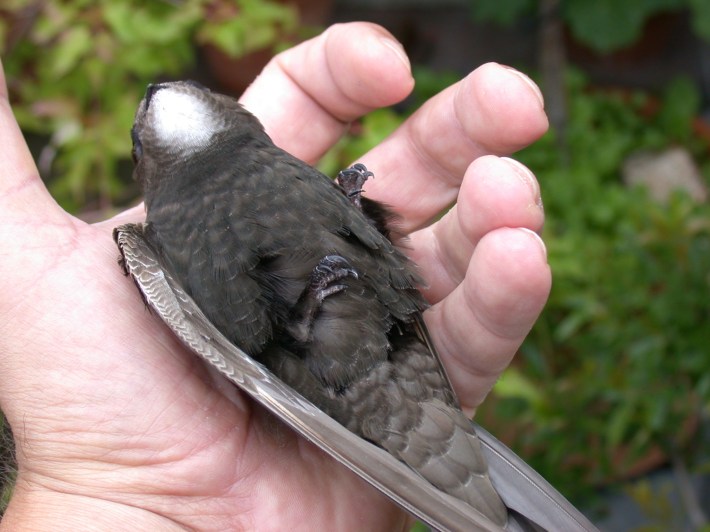
You couldn't convince me this young common swift isn't actually dead. This bird is in perfect dead-bird form: on their back, claws slightly curled, beak upturned toward the sky. Perhaps the gray tones of the bird add to this air of death, as if this was a bird transported from an era before color photography. Of course a bird from the 19th century could not possibly be alive now! I guess I also see lots of photos of dead songbirds that died after colliding with windows, which is tragically common and often preventable, and many look just like this, pristinely preserved and stiffly tummy-up. Excellent.
2. Brown widow spider
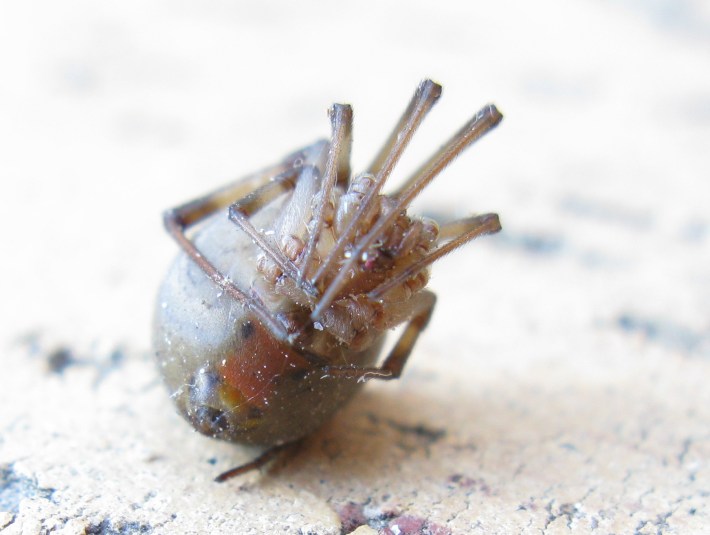
According to Wikipedia, this brown widow spider apparently fell into thanatosis after she was shaken from her web, which seems to me a perfect occasion for thanatosis. I am thoroughly convinced of this spider's death. I have seen many small dead spiders in my life, spindly legs curled into little meatballs that rest on my windowsill or under a dresser for long spells of time. If this spider were simply on her side, perhaps resting, legs out like a pig, I would not be so quick to believe her. But she has gone the extra mile to curl her legs and rest slightly askew from the ground.
3. Green-headed ant

This green-headed ant (right) appears to be quite successfully tricking the black house ant (left) that seeks to attack them. However I can't fairly give a higher rating because the green-headed ant is too blurry in the photo, and there must be subtleties to their pose, the curl of their body, and their general demeanor that I could more fully critique if the whole photo were in focus. But the overall, blurry impression is certainly impressive; look at those curled legs!
4. Opossum
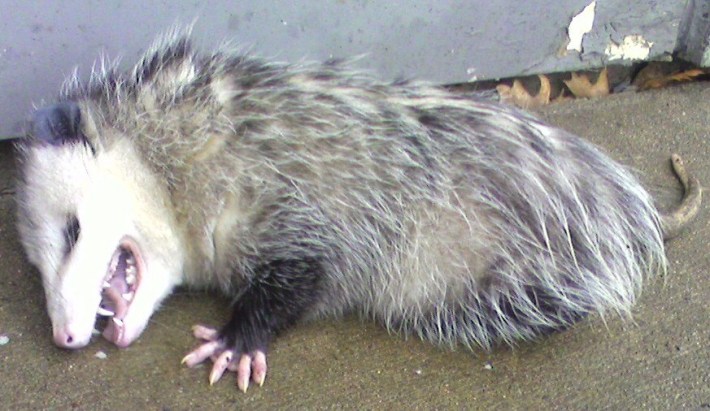
This opossum seems to be doing a fine job, but consider the larger context. Opossums are infamous for this scam, and I won't be easily fooled! If I recall correctly, the first thing I learned about opossums was that they play dead. I have seen the videos on YouTube and TikTok of melodramatic opossums being found out mid-scam. If I saw an actually dead opossum and tried to rouse them back to life, tried poking them and feeding them some of their favorite foods, such as eggs, frogs, insects, and dead animals, if I brought the opossum back to my house and set them up in the guest room and waited for days for the opossum to resuscitate, if the opossum remained motionless and a foul stench began wafting from the guest room, even then I would not necessarily be convinced the opossum was not playing the long game to fool me. If I am to believe an opossum to be truly dead, there better be some fake blood or tire tracks or something real! A good apparent death hampered by a crowded field.
5. Sleeper cichlid
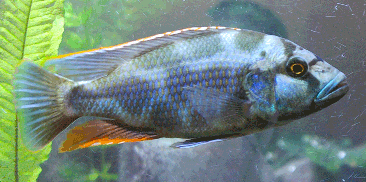
So this photo of a sleeper cichlid clearly does not depict the cichlid actually playing dead. I stared at this photo for several minutes trying to understand how this cichlid might appear dead—maybe its disguise is only perceptible to fishes. But then I read the accompanying text, which shares that sleeper cichlids play dead in order to hunt, as a form of what is called aggressive mimicry. The cichlids will lie on their side on the bottom of the lake with a blotchy coloration, suggestive of a rotting carcass. This sounded fantastic and almost unbelievable, so I found a video on Youtube that shows a Livingston's cichlid doing just that. I imagine the creators of the Wikipedia page may not have been able to find footage of this fish doing this particular action in the public domain, but were so enthralled with this behavior that they still chose to include an unrelated photo of the fish. I respect that decision, and this cichlid.
6. Barred grass snake

Is this what a dead snake is supposed to look like? This barred grass snake looks downright gleeful. Why are they smiling so big! I went to the barred grass snake's Wikipedia page to see what the snake looks like alive (very normal, very snake-y), which actually has a much better photo of the snake feigning death, entirely tummy-up in the grass. I have to wonder, why was this photo not included in the Wikipedia article with the ostensible purpose of offering different examples of thanatosis? And open, grinning mouth aside, nothing else about this snake's posture suggests death. Being coiled up has huge "alive" vibes, at least to this layperson. Perhaps there is something I am missing, and this snake could trick someone who knows a lot about snakes and why this may actually be a great impression of a dead barred grass snake. But this thoroughly alive snake is not fooling me, not today. The extruded tongue is a nice touch.
7. Burmeister's leaf frog
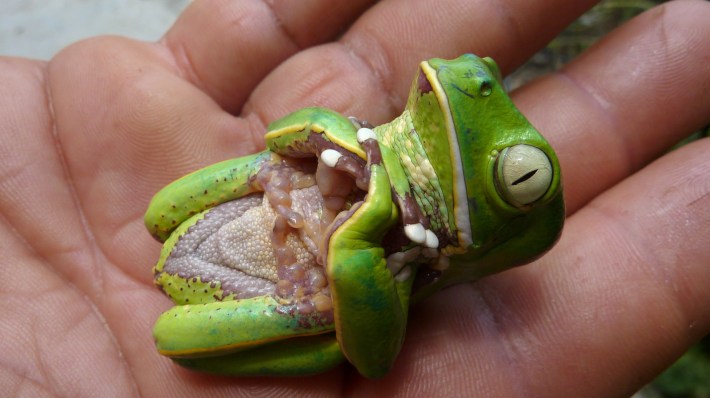
Not only does this Burmeister's leaf frog not look dead, they look suspicious. Conniving, even. They look like a villain in a Pixar movie about a young fly living in Brazil's Atlantic Forest who feels insecure about how they are less flashy and venomous than all the other tropical insects, because Brazil's Atlantic Forest is home to many flashy organisms, and the fly's insecurity about their appearance means they seek approval from dangerous characters like this frog. Maybe if this frog were in a more splayed position, or even had a tongue lolling out of their mouth like the barred grass snake, I would be more open to this interpretation of death. But this frog looks tense and actively uncomfortable, a body position that actually makes me look at the frog more closely. I actually cannot stop looking at this frog, and the longer I look, the more uneasy I feel. And the longer I stare, the more it feels like the frog is staring back at me.
8. Eastern hog-nosed snake
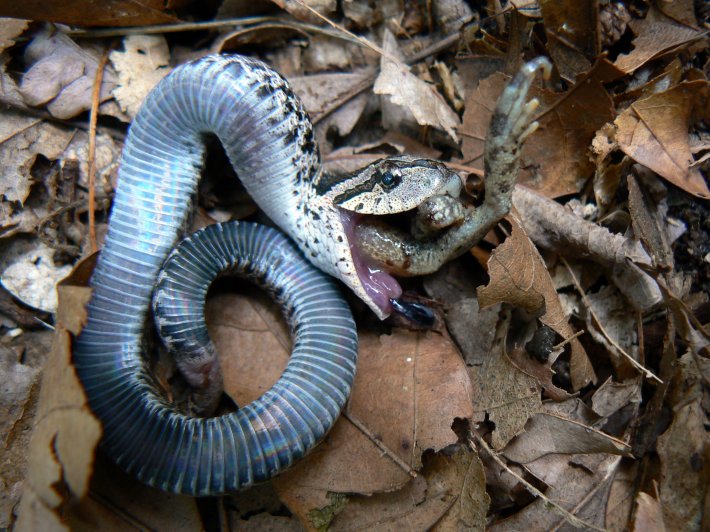
What can I even say? This photo is like if Caravaggio lived in the age of digital cameras and was an amateur wildlife photographer. This eastern hog-nosed snake is serving biblical omen. And the regurgitated frog whose legs are elegantly protruding from the snake's mouth is serving something, maybe ballerina? Alien from Alien? The eastern hog-nosed snake is "renowned" for this death-feigning melodrama, flipping on its back, convulsing, defecating, expelling a stinky musk and regurgitating its food, according to the Florida Museum. Does the snake look dead? I suppose I feel deeply ambivalent; the snake certainly looks unwell, but they look too dynamic for something dead. But I do know one thing. If I saw this snake do this thing, I would not blink before heading in the opposite direction. This is a snake that pulls no punches, that fears no god, that stops at nothing to save themselves, and if the ultimate goal of feigning death is to live another day, this snake resoundingly succeeds.






